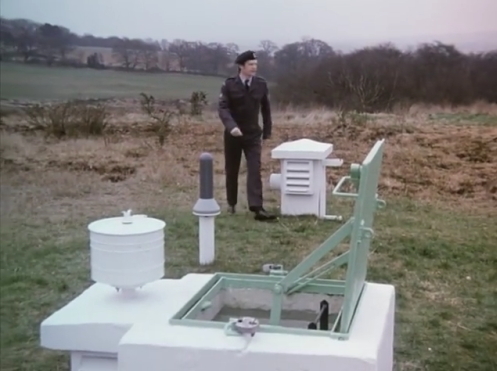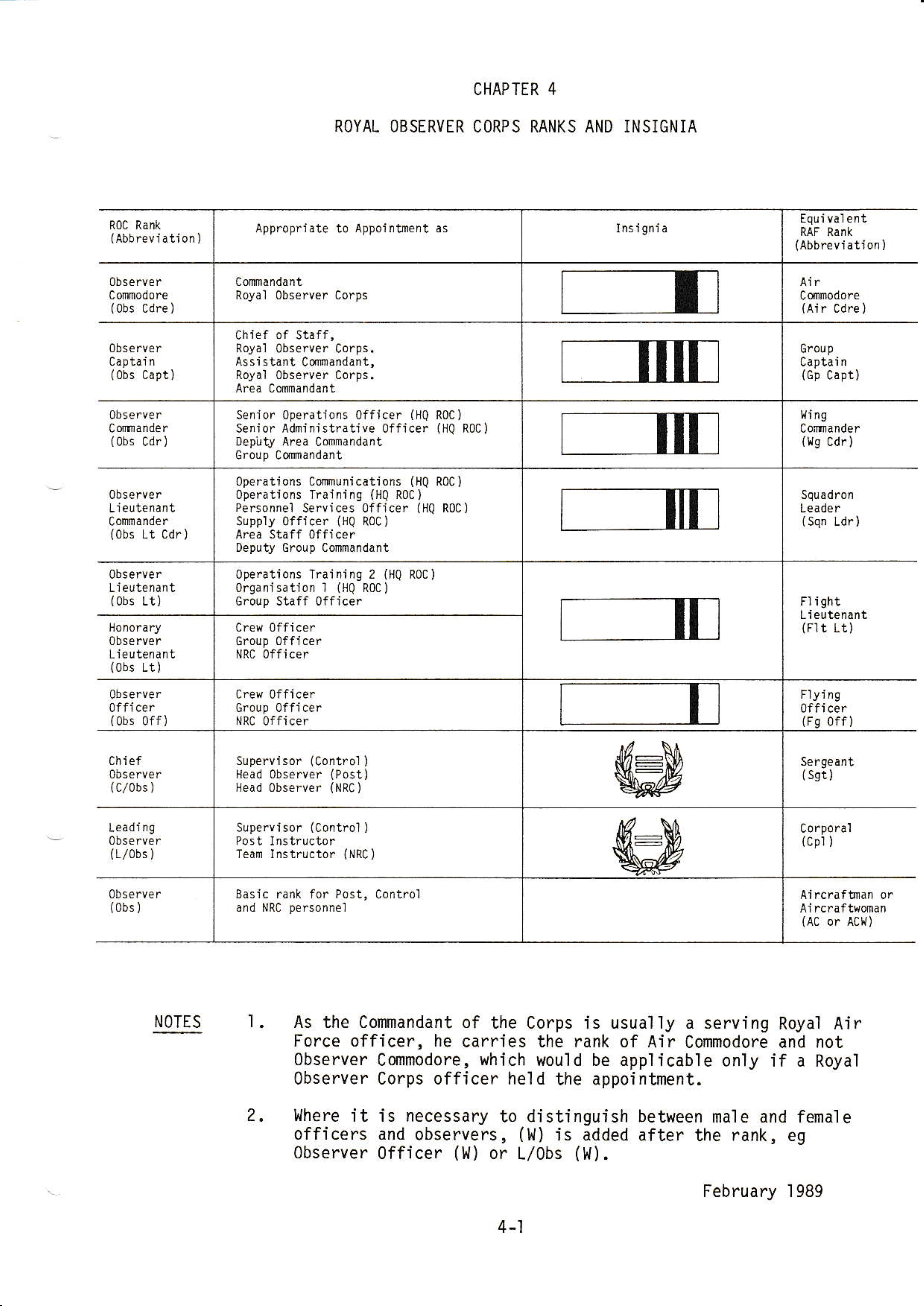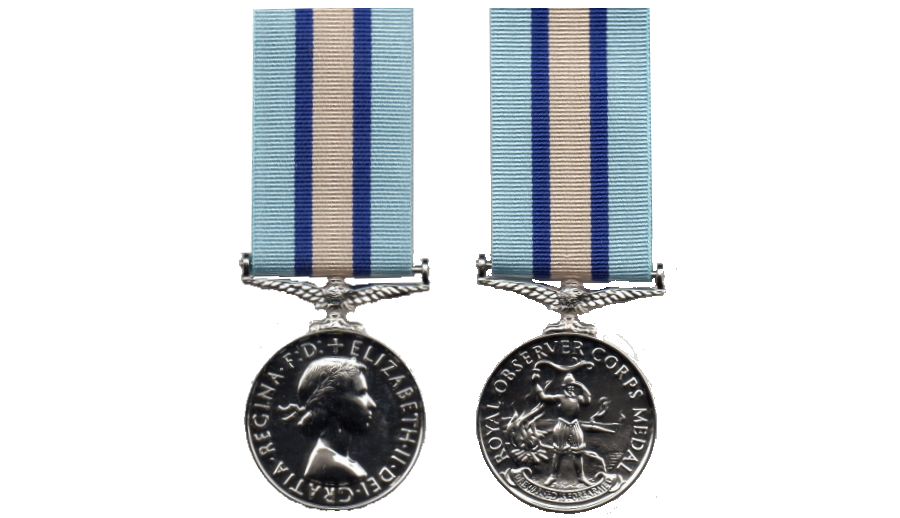Royal Observer Corps
In 1925 trials involving a network of observation posts linked by telephone were carried out in co-operation with the RAF to test a system for identifying and tracking enemy aircraft. The trials were so successful that the Observer Corps were set up in the same year. Initially the network was confined to the Maidstone and Horsham areas but during the 1930's as the threat of war increased the Observer Corps system was extended to cover the whole of the British Isles.Composed mainly of civilian spare-time volunteers, ROC personnel wore a RAF-style uniform and latterly came under the administrative control of RAF Strike Command and the operational control of the Home Office. Civilian volunteers were trained and administered by a small number of professional full-time officers under the command of the Commandant Royal Observer Corps; latterly a serving RAF Air Commodore.
World War II
By the outbreak of the Second World War the aircraft identification and reporting organisation of the Corps covered most of England, Scotland and Wales, and by early 1941 there was complete coverage by thirty-nine Groups organised in five areas. Operational control was exercised through the Headquarters at Bentley Priory.
The Corps was called out for duty on 24 August 1939 and maintained continuous day and night watch over the sky of Great Britain until stood down on 5 May 1945. The vital service rendered by the Corps in the Battle of Britain was acknowledged as outstanding, and on 11 April 1941 King George VI was "...graciously pleased to approve that the Observer Corps should henceforward be known by the style and description of the "Royal Observer Corps.", in recognition of its long and valuable service.
The Corps also distinguished itself in other fields, in offensive operations by the Royal Air Force through adapting itself to new enemy tactics, in the success achieved by its "Seaborne" aircraft identifiers aboard ships participating in the invasion of Normandy, and its success in meeting the flying bomb attacks. The first V1 was identified by the ROC. Another aspect of the work of the Corps during these years was the tracking of friendly distressed aircraft many of which were helped and guided to safety and many lives saved.
Cold War
Although the Royal Observer Corps was "stood-down" after the war, the organisation was continued by a nucleus of full-time officers and by many volunteers who nevertheless continued to serve. By Royal Warrant the Corps was re-formed, in its air defence role on l January l947.On 31 January 1950, King George VI instituted and created the Royal Observer Corps medal to signify the Sovereign's appreciation of long and meritorious service in the Corps. This medal was awarded after twelve years and a clasp after twenty-four years satisfactory service, WWII service counted for length of service
On 11 April 1950, the King further honoured the Corps by assuming the appointment of Air Comodore-in-Chief, Royal Observer Corps, in recognition of the Corps' record of service during the twenty-five years of its existence. On 1 June 1953 Her Majesty Queen Elizabeth II assumed the appointment of Air Commodore-in-Chief. On the 24 June 1966 the HM Queen Elizabeth II, reviewed a parade of 103 Officers and 653 Observers representing all Groups of the Corps at RAF Bentley Priory and presented the Royal Observer Corps Banner, in recognition of the Corps long service and achievement.
Operation
"Pinnacle" 1951 � British Pathe
The Royal Observer Corps and its nuclear role
In 1955 the role of the ROC changed from aircraft identification to the Cold War role of identifying nuclear weapons bursts and the tracking of radiation. Previously the tracking of radiation had been the responsibility of the Scientific and Reconnaissance sub-Section of the Civil Defence Corps Headquarters Section.
The Corps underwent considerable re-training and re-organisation to carry out the vital task of being ready to report the position and power of nuclear weapons burst over the United Kingdom, and thereafter recording and reporting the intensity of the resultant radio-active fall-out. To perform this role a total of 1,560 underground Royal Observer Corps Posts and 29 heavily protected Royal Observer Corps Group Headquarters were built to enable the Corps to meet its task. The posts were evenly spread throughout England, Scotland, Wales and Northern Ireland, the Isle of Man, the Channel Islands and extended to Orkney, Shetland and the Hebrides.
Posts were equipped with specialised equipment for their new role, including the fixed survey meter (FSM), bomb power indicator (BPI) and the ground zero indicator (GZI) details of these can be found on the Post Equipment page.
From 1955-57 the ROC reported to the RAF, but from then on they became the eyes of the United Kingdom Warning and Monitoring Organisation (UKWMO).
Observation Posts
The basic reporting units of the Corps were posts which were clustered in groups of two, three or four throughout the United Kingdom, using a common landline and/or radio link between each cluster and their parent Group Operations Room. Eight to sixteen clusters comprised an average Group, and five or six Groups formed the reporting organisation for a Sector Control, of which there were five to cover the United Kingdom. Command of the five or six Groups linked to each Sector was by an ROC Area Commandant and there were five Area Headquarters.
Each Post was designed as a self-supporting unit in which the crew of three or four could live and operate throughout the emergency, and was equipped with specially designed detection instruments and a communication system to adjacent Posts and the Group Operations Rooms.
The post diagrams have been redrawn from official documents, and show a vertical section, and a plan section of an ROC Post. Internally the monitoring room measured 15 feet by 7 foot 6 inches. Construction was of reinforced concrete, and was sub-surface with a variable thickness of soil above. Typically posts had a protective factor (PF) of about 5000. At various times the actual fittings and equipment varied, and also whether or not the post was a master post would affect some of the contents. The key equipment comprised the Ground Zero Indicator, the Bomb Power Indicator both of which were fitted from the earliest days of the nuclear monitoring role, radiation monitoring instruments and communications equipment.
During the gradual transition from the original aircraft reporting role to the nuclear task, the operational control of the Corps passed from Fighter Command to the Home Office, in association with the Home Departments of Scotland and Northern Ireland. Whilst the whole of the capital cost of rebuilding and instrumentation since 1955 had been funded by the Home Office, the operating costs of the Corps were shared proportionately between the Ministry of Defence and the Home Office.
Early in 1968 the Government Expenditure Review resulted in some elements of Home Defence (the Civil Defence Corps, and the Auxiliary Fire Service) being put on a care and maintenance basis (in other words most local authorities did nothing). The UK Warning and Monitoring Organisation was recognised as a specialised part of Home Defence with a function which was vital, but the costs of the ROC were reduced as a part of economies within the United Kingdom Warning and Monitoring Organisation. This meant reducing the number of ROC posts to 873 posts (from over 1500) linked to 27 Group Headquarters (reduced from 31). In addition five Home Office Sector Controls were re-positioned within selected Group Headquarters. The task of providing most of the manning for these Sectors was now an ROC responsibility.
Training
The routine training of the Corps was based on regular meetings of spare-time Post and Operations Room crews, following a syllabus laid down by Headquarters ROC, and culminating in an annual test which took place simultaneously throughout all Groups in March each year. This basic training for Posts was in the hands of Chief and Leading Observers, co-ordinated by Group Officers who normally had responsibility for up to two clusters. In the Operations Room each Duty Controller, with the Chief and Leading Observers, had similar responsibility for basic training. The routine training of both Post and Operation Room crews was reinforced at more centralised training meetings organised on a cluster or combined crew basis, and this process was continued at the larger Group Meetings and Training Courses arranged by the Group or Area Headquarters. Where possible Group meetings were held at RAF Stations. Practical exercises were arranged several times a year when the whole Corps was fully operational.
From 1948 Annual Training Camps were held for Officers and Observers from all Groups of the Corps. Each of the five weekly Training Camps were held in series with the same programme repeated each week. The overall supervision was by full-time ROC staff officers but spare time officers and NCOs who attended Camp were co-opted to assist in the day to day practical training and supervision. The main body of each Camp assembled on the Monday and dispersed on the following Saturday with the work being divided between theoretical and practical training.
Proficiency badges
Badges were issued for passes in Master tests which were held on an annual basis, issued according to the following schedule:
| Number of passes | Badges |
|
1 5 10 15 20 25 30 35 40 |
Blue Spitfire Red Spitfire Red Spitfire + one red star Red Spitfire + two red stars Red Spitfire + three red stars Gold Spitfire Gold Spitfire + one gold star Gold Spitfire + two gold stars Gold Spitfire + three gold stars |
Group Headquarters
| ROC Group Headquarters | |
| ROC Group No 1 - Maidstone ROC Group No 2 - Horsham ROC Group No 3 - Oxford ROC Group No 4 - Colchester ROC Group No 5 - Watford ROC Group No 6 - Norwich ROC Group No 7 - Bedford ROC Group No 8 - Coventry ROC Group No 9 - Yeovil ROC Group No 10 - Exeter ROC Group No 11 - Truro ROC Group No 12 - Bristol ROC Group No 13 - South Wales ROC Group No 14 - Winchester ROC Group No 15 - Lincoln - (RAF Fiskerton) |
ROC Group No 16 - Shrewbury
ROC Group No 17 - North Wales (RAF Wrexham) ROC Group No 18 - Leeds ROC Group No 20 - York ROC Group No 21 - Preston (Goosnargh) ROC Group No 22 - Carlisle (RAF Carlisle) ROC Group No 23 - Durham ROC Group No 24 - EDINBURGH (RAF Turnhouse) ROC Group No 25 - Ayr ROC Group No 27 - Oban ROC Group No 28 - Dundee 1953 - 1964 - Barnton Quarry 1964 - 1976 - School Hill, Aberdeenshire ROC Group No 29 - Aberdeen ROC Group No 30 - Inverness ROC Group No 31 - Belfast (Thiepval Barracks) |
The Group Headquarters were designed to house a crew of 40/50 people throughout any emergency and were equipped with independent lighting, heating, ventilation systems and domestic facilities.
The Operations Rooms at Groups had operational displays, using the basic information received from posts and this formed the basis of the warning messages to the public. The vulnerability of landline communications to nuclear attack was recognised rather late and action taken to extend the radio network at all levels was still not complete at the time of stand-down in 1992. A modern system of automatic data transmission equipment had been installed in all ROC Group Operations Rooms.






